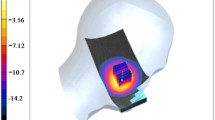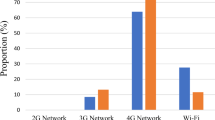Abstract
Today world population lives in a new electromagnetic environment, characterized with (i) around the clock enforcement of chronic exposure of all age and gender groups to a wide range of modulated electromagnetic fields (EMF) from base stations; (ii) daily, repeated from early childhood throughout entire life exposure to EMF RF mobile phone the brain and vestibular receptor apparatus and auditory analyzers, located directly “under the EMF beam” in the inner ear. On the other hand, the world science and epidemiology is missing well-planned and executed research results of prolonged exposure of EMF RF on the brain. International recommendations and domestic guidelines do not include changing conditions of RF EMF on the population: the brain has become a critical organ, and the children entered the risk group. The population continues to actively use the mobile phone. In this situation the problem of assessing the risk of mobile communications has become a social and ethical.


Similar content being viewed by others
References
Ahlbom A, Feychting M, Green A et al (2009) Epidemiologic evidence on mobile phones and tumor risk: a review. Epidemiology 20:639–652
Aphrikanova LA, Grigoriev Yu (1996) Influence of an electromagnetic radiation of various modes on heart activity (in experiment). J Rad Biol Ecol (Russ Acad Sci) 36(5):691–699
Bernhardt J (1999) Criteria for the development of international standards. In: Proceedings of international conference. “Electromagnetic fields: biological effects and hygienic standardization” Moscow, May, 1998. Electromagnetic fields: biological effects and hygienic standardization. WHO, Geneva, pp 19–30
Chou C-K, D’Andrea J, Tell R et al (2003) Progress of IEEE C95.1-1991 RF safety standard revision. In: Proceedings of the 3rd international of EMF seminar in China: EMF and biological effects. Guilin, China, p 54
David E, Reigenweber J, Kentner S (1999) The nature of electromagnetic hypersensitivity. In: Proceedings international of conference. “Electromagnetic fields: biological effects and hygienic standardization” Moscow, May, 1998. Electromagnetic fields: biological effects and hygienic standardization. WHO, Geneva, pp 291–296
Dec S, Cieslak E, Miszczak J (1997) Abstract book second World congress for electricity and magnetism in biology and medicine. Bologna, Italy, p 273
Freude G, Uleperger P, Eggert S (1997) Abstract book Second World congress for electricity and magnetism in biology and medicine. Bologna, Italy, p 272
Grigor’ev Yu, Luk’janova S, Rynskov V, Grigor’ev O, Makarov VP (1999) Reaction of the person to electromagnetic radiation of a cellular telephone. In: Electromagnetic fields. Biological action and hygienic normalization. WHO, Geneva, pp 525–5417
Grigoriev Yu (1995) Reaction of an organism in the weakened geomagnetic field (effect magnetic deprivation). Radiating biology. Radioecology 35(1):3–18
Grigoriev Yu (2005) Electromagnetic fields of cellular telephones and health of children and teenagers (a situation demanding acceptance of urgent measures). Radiating biology. Radioecology 45(4):442–450
Grigoriev Yu (2006) Electromagnetic fields of mobile communications and risk assessment for the population (the current state of and future research). J Med Emerg Situat 4(8):58–67
Grigoriev Y (2008) Russian NCNIRP Guidance. New condition of EMF RF exposure and guarantee of population health. In: Proceedings of the international conference “the global issue of EMF and health”. London, UK, pp 27–31
Grigoriev Yu (1999) The role of modulation in development of somatic effects. In: electromagnetic fields biological action and hygienic normalization. WHO, Geneva, pp 37–48
Grigoriev Yu (2002) Emotional stress and electromagnetic fields. ANNUAL BOOK-2002 of the Russian National Committee on Non-Ionizing Radiation Protection. Moscow, pp 25–33
Grigoriev Yu, Stepanov V (2000) Microwave effect on embryo brain: dose dependence and the effect of modulation. In: Klauenberg B (ed) Radio frequency radiation dosimetry. Kluwer, Dordrecht, pp 31–37
Grigoriev Yu, Grigoriev O, Merkulov A (2006) Base stations of a mobile radio communication and safety of the population: a general situation in Russia. ANNUAL BOOK- 2004–2005 of the Russian National Committee on Non-Ionizing Radiation Protection. Moscow, pp 31–35
Hallberg O, Oberfeld G (2006) Letter to the editor: will we all become electro sensitive. Electromag Biol Med 25:189–191
Handhi O, Lazzi P, Furse G (1996) Electromagnetic absorption in the human head and neck for cell telephones at 835 and 1900 MHz. IEEE Transact Microwav Theory Tech 44(10):1884–1897
Hardell L, Mild H (2003) Mobile and cordless telephones and association with brain tumours in different age groups. Abstract book. 5-th COST 281 MCM and workshop “mobile telecommunications and the brain”. Budapest, pp 15–16
Hardell L, Nasman A, Pahison A et al (1999) Use of cellular telephones and the risk for brain tumours: a case-control study. Int J Oncol 15:113–116
Hardell L, Hallquist A, Mild H et al (2002) Cellular and cordless telephones and the risk for brain tumors. Fur J Cancer Prev 11:377–386
Hillert L, Berglind N, Bellander T (2002) Scand J Work Environ Health 28(1):33–41
Huber R, Schuderer J, Graf Th et al (2003) Radio frequency electromagnetic field exposure in humans: estimation of SAR distribution in the brain, effects on sleep and heart rate. Bioelectromagnetics 24(4):262–276
Huder R, Graf T, Cote K et al (2000) Exposure to pulsed high-frequency electromagnetic fields during waking affects human sleep EEG. NeuroReport 11:3321–3325
Hudnitskij S, Moshkarev E, Fomenko T (1999) Studying of functional condition CNS and cardiovascular system at users of cellular telephones. In: Proceedings of the electromagnetic fields biological action and hygienic normalization. WHO, Geneva, pp 537–541
IARC/A/WHO (2011) Classifies radiofrequency electromagnetic fields as possibly carcinogenic to humans. Press release no. 208. p 3
Johansen C, Boice J, McLaughlin J et al (2002) Mobile phones and malignant melanoma of the eye. Br J Cancer 86:348–349
Johansson O (2008) Aspects of studies on the functional impairment electrohypersensitivity. In: Proceedings of the international conference of electromagnetic fields and health-a global issue. London, pp 31–34
Khorseva N (2004) Ecological value of natural electromagnetic fields during intra-uterine development of the person. Dissertation, p 144
Khorseva N, Grigoriev Yu, Gorbunova N (2011a) Psychophysiology parameters of children—users mobile communication (connection). The message 2. Results of four-year-old monitoring. Radiating biology. Radioecology 51(5):617–623
Khorseva N, Grigoriev Yu, Gorbunova N (2011b) Psychophysiology parameters of children—users mobile communication. The message 1. A modern condition of a problem. Radiating biology. Radioecology 51(5):611–616
Klieeisew N (2001) The child scrambler-what a mobile caw do youngster’s brain in 2 minutes. UK. Sunday Mirror, Decem
Koivisto M (2000) Effect of 902 MHz electromagnetic field emitted by cellular telephones on response times in human. Cogn Neurosci Neuropsychol 11(27):413–415
Krause Ch (2000) Effects of electromagnetic field emitted by cellular phones on the EEG during a mamorytask. Cogn Neurosci Neuropsychol 11(4):761–764
Lahkola A, Auvinen A, Raitanen J et al (2007) Mobile phone use and risk of glioma in 5 north European countries. Int J Cancer 120:1769–1775
Lee T, Lan P, Yee L et al (2003) The effect of the duration of exposure to the electromagnetic field emitted mobile phones on human attention. NeuroReport 14(10):1361–1364
Levallois P et al (2002) Study of self-reoorted hypersensitity to electromagnetic fields in California. Environ Health Persp 110(4):619–623
Mild Í, Offedal G, Sandstrom Ì et al (1998) Comparison of symptoms experienced by users of analogue and digital mobile phones À Swedish-Norwegian epidemiological study. Arbetslivsrapport 23:1401–2928
Muscat J, Malkin M, Shore R et al (2002) Handheld cellular telephones and risk of acoustic Neuroma. Neurology 58:1304–1306
Panda N, Jain R, Bakshi J (2007) Otolaryngology-Head (Suppl):131–132
Preece A (2002) Studies on children and mobile phone interactions with cognition. In: Proceedings of the COST 281 workshop on mobile phones and children. Rome, pp 20–26
Preece À, Iwi G, Davies-Smith A, et al. (1999) Effect of à 915 MHZ simulated mobile phone signal on cognitive function in mahn. In: Proceedings 1st international medical scientific congress “non-ionizing high frequency EM radiations”. Rome, Italy, p 34
Salford L, Bertil R, Persson B, Brun A (1997) Neurological aspects on wireless communication. In book “non-thermal effects of RF electromagnetic fields”. ICNIRP 131–143
Salford L, Brun A, Eberhart J, Malmgren L, Persson B (2003) Nerve cell damage in mammalian brain after exposure to microwaves from GSM mobile phones. Environ Health Perspect 111(7):881–883
Sandstrom Ì, Otedal G, Mild Í (2001) Mobile phone use and subjective. Comparison of symptoms experienced by users of analogue and digital mobile phones. Occup Med 51(1):25–32
Schuz J, Bohler E, Berg G et al (2006) Cellular phones, cordless phones, and the risk of glioma and meningioma (Interphone Study Group, Germany). Am J Epidemiol 163:512–520
Suvorov G, Paltsev J, Rubtsova N et al (2002) Questions of biological action and hygienic normalization of the electromagnetic fields created by means of mobile communication. Med Work Ind Ecol 9:10–18
Thuroczy G, et al. (1997) Abstract book second world congress for electricity and magnetism in biology and medicine. Bologna, Italy, pp 164–165
WHO (2003) Healthy environment for children. Backgrounder no. 3. p 3
Author information
Authors and Affiliations
Corresponding author
Rights and permissions
About this article
Cite this article
Grigoriev, Y. Mobile communications and health of population: the risk assessment, social and ethical problems. Environmentalist 32, 193–200 (2012). https://doi.org/10.1007/s10669-011-9371-4
Published:
Issue Date:
DOI: https://doi.org/10.1007/s10669-011-9371-4




